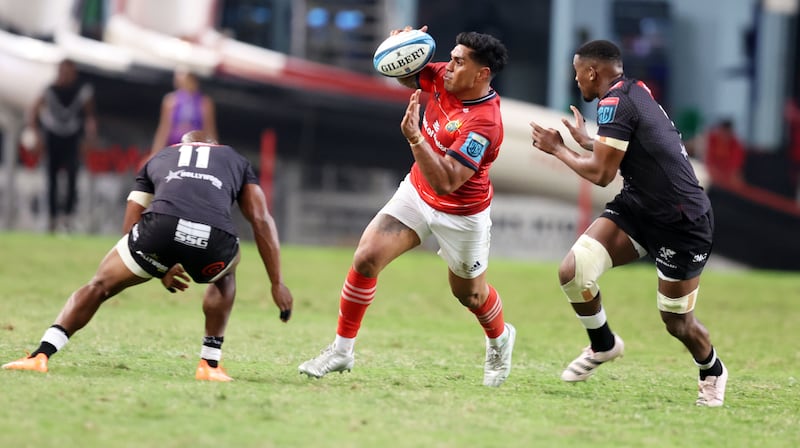As summer has arrived and Andy Farrell and his Irish team have started their Rugby World Cup preparations, there is some dangerously overconfident chatter suggesting that the tournament is a two-horse race between the northern hemisphere giants, France and Ireland.
Only once across nine World Cups has a northern hemisphere team prevailed. So history tells us that under no circumstances should anyone write off the south.
Students of the game who watched the Super Rugby playoffs would have come to the conclusion that New Zealand rugby is in great shape. The final between the Canterbury Crusaders and the Waikato Chiefs was an epic encounter, providing a window into the current thinking of the Kiwis.
Right across New Zealand rugby, the battlefield at the breakdown has been lifted to new heights of competition. The physical intensity and technical excellence at the tackle from both teams in the Super Rugby final was of the highest standard.
READ MORE
In the upcoming World Cup, many of the New Zealand tactics will focus on attacking the space below and behind their opponents. With exceptionally low body height, the Kiwis will be contesting every tackle, aiming to get under the attacking support players and disrupt opponents’ attacks by stealing possession or forcing a penalty.

The lightning-fast acceleration of their outhalves, Beauden Barrett and Richie Mo’unga, creates individual attacking threats that force defensive lines to stay tight and rush forward to limit the time these exceptional players have with the ball in their hands.
In rushing forward to contain Barrett and Mo’unga, defensive systems are forced to leave space behind their lines. The attacking kicking skills of Barrett and Mo’unga, who can both land a rugby ball on a 10-cent piece, will kick behind the defenders, aiming for their chasing players to regather possession and score.
The South Africans are in a different situation altogether. They are trying to tame a beast created by a calendar that forces them to play in elite competitions in both hemispheres. At club level, the South Africans have abandoned Super Rugby for the northern URC and the Champions Cup. Yet their national team remains in the southern Rugby Championship.
As the northern hemisphere players have taken a few weeks’ holiday and have just returned for an extended and well-planned build-up to the September start of the World Cup, the Springboks still have their boots strapped on for matches against the Pumas, Wallabies and New Zealand that start next week.
By the time of the World Cup final on October 28th, many of the South African players will have been in continuous competition for almost 15 months. The South African players have been managed and given breaks during the season, but it is a situation that is far from ideal for elite athletic performance.
With some South African club teams forced to make up to nine long-haul flights to Europe across their season and with multiple more in front of them during the Rugby Championship, followed by eight weeks in hotels in France, physical and mental burnout is a real factor for the Springboks.
There is no doubt that by deciding to compete in both hemispheres in the year before the World Cup the South Africans have created an unprecedentedly long season for themselves to manage. While the Springboks remain a colossus, their playing schedule is a real burden that will produce fatigue later in the tournament.
However, early in the tournament, when Ireland walk on to the Stade de France to confront the Springboks on September 23rd, the threat they pose cannot be overstated.

Ireland face other real obstacles from the south. A rejuvenated Tongan team are also in Ireland’s pool. Under the new laws surrounding eligibility, Tonga have been injected with reinstated players from Tier One nations. Former Wallabies Israel Folau and Adam Coleman will join New Zealand internationals Malakai Fekitoa and Charles Piutau, so Tonga have to be taken seriously. Alongside Scotland, the Springboks and Tonga, Ireland are in the most competitive pool in the tournament by a considerable margin.
Sitting quietly on the other side of the draw, the Pumas and the Wallabies are smiling, watching all of this hand-wringing. Wrongly dismissed by the north, their path to a semi-final is far easier than those of Ireland, France, New Zealand or South Africa.
The return of Eddie Jones, aligned with the high-quality performances of the Brumbies, with relative improvements from both Queensland and the Waratahs in Super Rugby, mean that, in the short term, the Wallabies’ performances should considerably improve.
Last November, despite having a long list of injured players unavailable, the men in gold played excellent rugby against Ireland and France. With Wales as the only Tier One opposition in their pool, Australia can manage their limited personnel resources across the pool matches to maximise their performances in the knockout rounds.
If they can reach the last eight in good health, they have Jones’s unparalleled World Cup coaching experience to guide them. As a head or assistant coach, Jones has reached three World Cup finals. The Wallabies may not have the talent to win the World Cup but their pathway to the final is far smoother than those of Ireland or France.
Last season, under Michael Cheika’s leadership, Argentina defeated New Zealand, England and Australia. They are proof that on any given day every team in World Rugby’s top eight rankings are capable of beating each other. That makes this the most open World Cup in its history for an outsider to win.
The vagaries of the draw have placed both the Pumas and Wallabies in a powerful position to pounce in the knockout stages. As the south prepares for the start of the Rugby Championship on July 8th, the north would do well to watch closely and remember that, while Ireland and France can win the World Cup, the draw and history suggests otherwise.

















